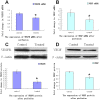Tumor angiogenesis after heated lipiodol infusion via the hepatic artery in a rabbit model of VX2 liver cancer
- PMID: 23637861
- PMCID: PMC3634808
- DOI: 10.1371/journal.pone.0061583
Tumor angiogenesis after heated lipiodol infusion via the hepatic artery in a rabbit model of VX2 liver cancer
Abstract
Objectives: This study aimed to observe the changes in tumor angiogenesis after heated lipiodol (60°C) infusion via the hepatic artery in a rabbit model of VX2 liver cancer.
Materials and methods: Twenty rabbits with VX2 hepatic tumors were randomly divided into 2 groups (10 rabbits in each group). Under anesthesia, a trans-catheter hepatic arterial infusion was performed, and lipiodol (37°C; control group) or heated lipiodol (60°C; treated group) was injected into the hepatic arteries of the animals. Then, changes in tumor angiogenesis were assessed using the following markers and methods. 1. Vascular endothelial growth factor receptor (VEGFR) and vascular endothelial growth factor (VEGF) expression levels in the tumor were assessed using western blotting and real-time quantitative polymerase chain reaction (PCR). 2. Proliferating cell nuclear antigen (PCNA) expression in the tumor was assessed through immunohistochemical staining. 3. The morphological changes in tumor vascular endothelial cells were observed using transmission electron microscopy (TEM).
Results: VEGFR and VEGF mRNA and protein expression levels were reduced in the treated group compared to the control group. PCNA protein showed reduced expression levels in the treated group compared to the control group. TEM indicated that the endothelial cell endoplasmic reticulum expanded, the chondriosome was swollen, and the endothelial cell microvilli were decreased after heated lipiodol infusion.
Conclusions: The tumor angiogenesis of rabbits with VX2 cancer was inhibited after arterial heated lipiodol infusion compared to lipiodol infusion.
Conflict of interest statement
Figures




Similar articles
-
[Effects of transcatheter arterial chemoembolization with pingyangmycin-lipiodol emulsion on VX2 liver tumors in rabbits].Zhonghua Gan Zang Bing Za Zhi. 2012 Aug;20(8):611-6. doi: 10.3760/cma.j.issn.1007-3418.2012.08.014. Zhonghua Gan Zang Bing Za Zhi. 2012. PMID: 23207156 Chinese.
-
Transcatheter arterial infusion with heated saline changes the vascular permeability of rabbit hepatic tumors.Acad Radiol. 2011 Dec;18(12):1569-76. doi: 10.1016/j.acra.2011.08.010. Epub 2011 Oct 2. Acad Radiol. 2011. PMID: 21968263
-
Angiogenesis in rabbit hepatic tumor after transcatheter arterial embolization.World J Gastroenterol. 2004 Jul 1;10(13):1885-9. doi: 10.3748/wjg.v10.i13.1885. World J Gastroenterol. 2004. PMID: 15222029 Free PMC article.
-
Transarterial Chemoembolization Using Sorafenib in a Rabbit VX2 Liver Tumor Model: Pharmacokinetics and Antitumor Effect.J Vasc Interv Radiol. 2016 Jul;27(7):1086-92. doi: 10.1016/j.jvir.2016.02.032. Epub 2016 May 11. J Vasc Interv Radiol. 2016. PMID: 27179404
-
Treatment of Liver Tumors with Lipiodol TACE: Technical Recommendations from Experts Opinion.Cardiovasc Intervent Radiol. 2016 Mar;39(3):334-43. doi: 10.1007/s00270-015-1208-y. Epub 2015 Sep 21. Cardiovasc Intervent Radiol. 2016. PMID: 26390875 Review.
Cited by
-
Novel mouse models of hepatic artery infusion.J Surg Res. 2017 Nov;219:25-32. doi: 10.1016/j.jss.2017.05.083. Epub 2017 Jun 21. J Surg Res. 2017. PMID: 29078890 Free PMC article.
-
Combining Chemistry and Engineering for Hepatocellular Carcinoma: Nano-Scale and Smaller Therapies.Pharmaceutics. 2020 Dec 20;12(12):1243. doi: 10.3390/pharmaceutics12121243. Pharmaceutics. 2020. PMID: 33419304 Free PMC article. Review.
-
Dynamical observation on biological progression of VX2 liver tumors to identify the optimal time for intervention in animal models.PLoS One. 2013 Aug 16;8(8):e74327. doi: 10.1371/journal.pone.0074327. eCollection 2013. PLoS One. 2013. PMID: 23977399 Free PMC article.
-
Establishment of metastatic liver carcinoma model by implanting AX7 cells into rabbit liver, and its histological findings.Int J Med Sci. 2019 Jan 29;16(3):409-415. doi: 10.7150/ijms.28998. eCollection 2019. Int J Med Sci. 2019. PMID: 30911275 Free PMC article.
-
The impact of high co-expression of Sp1 and HIF1α on prognosis of patients with hepatocellular cancer.Oncol Lett. 2016 Jul;12(1):504-512. doi: 10.3892/ol.2016.4634. Epub 2016 May 26. Oncol Lett. 2016. PMID: 27347172 Free PMC article.
References
-
- Vogl TJ, Trapp M, Schroeder H, Mack M, Schuster A, et al. (2000) Transarterial chemoembolization for hepatocellular carcinoma: volumetric and morphologic CT criteria for assessment of prognosis and therapeutic success-results from a liver transplantation center. Radiology 214: 349–357. - PubMed
-
- Llovet JM, Bruix J (2003) Systematic review of randomized trials for unresectable hepatocellular carcinoma: Chemoembolization improves survival. Hepatology 37: 429–442. - PubMed
-
- Achenbach T, Seifert JK, Pitton MB, Schunk K, Junginger T (2002) Chemoembolization for primary liver cancer. Eur J Surg Oncol 28: 37–41. - PubMed
-
- Marelli L, Stigliano R, Triantos C, Senzolo M, Cholongitas E, et al. (2007) Transarterial therapy for hepatocellular carcinoma: which technique is more effective? A systematic review of cohort and randomized studies. Cardiovasc Intervent Radiol 30: 6–25. - PubMed
Publication types
MeSH terms
Substances
LinkOut - more resources
Full Text Sources
Other Literature Sources
Miscellaneous

